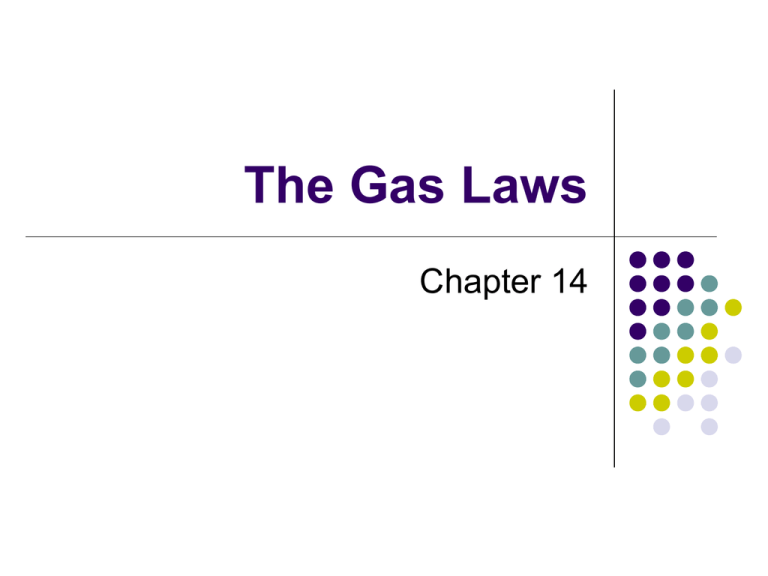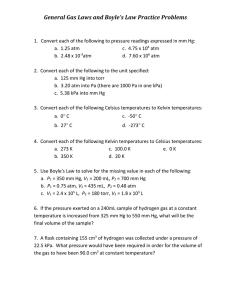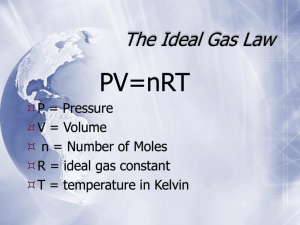The Gas Laws
advertisement

The Gas Laws Chapter 14 The Kinetic Molecular Theory Gas particles do not attract or repel each other Gas particles are very small with large amounts of space between them Gas particles are in constant random motion Gas particles have elastic collisions – no energy lost Gas particles have the same average kinetic energy at the same temperature Gas Pressure Gas particles exert pressure when they collide with the walls of their containers Temperature, volume, and the number of moles affect the pressure that a gas exerts Pressure Units SI unit for pressure – Pascal (Pa) 101.3 kPa = 1 atm 760 mm Hg = 1 atm 760 torr = 1 atm Gas Laws 4 factors that affect gases – when one changes it changes the other factors Volume Temperature Pressure Moles (# of particles) Boyle’s Law As the volume of a container of gas decreases, then the pressure of that gas increases This is an inverse relationship (as one goes up the other goes down) Temperature remains constant P1 V 1 = P2 V 2 Boyle’s Law – Sample Problem P1V1 = P2V2 P1 = 1.2 atm check to make sure your P2 = x your units are the same V1 = 3.5 L V2 = 6.4 L (1.2)(3.5) = P2(6.4) (1.2)(3.5) = P2 (6.4) 0.66 atm = P2 Boyle’s Law – Sample Problem P1V1 = P2V2 P1 = 7.5 atm check to make sure your P2 = 10.3 atm your units are the same V1 = x V2 = 2.65 L (7.5)V1 = (10.3)(2.65) (10.3)( 2.65) = V1 (7.5) 3.6 L = V1 Boyle’s Law Homework – pg. 422 # 1-5 Charles’ Law As the temperature of a gas increases so does its volume This is a direct relationship (the both change in the same direction) Pressure remains constant V1 T1 = V2 T2 Temperature must be in Kelvin K = Celsius + 273 Charles’ Law – Sample Problem V1 = 3.4 L V2 = 7.8 L T1 = 45°C T2 = x check to make sure your your units are the same (45 + 273 = 318) 3 .4 7.8 = 318 T2 (7.8)(318) = T2 (3.4) cross multiply 729 K = T2 729 – 273 = 456°C 460°C Gay Lussac’s Law As the pressure of a gas increases so does its temperature This is a direct relationship (the both change in the same direction) Volume remains constant P1 T1 = P2 T2 Temperature must be in Kelvin Gay Lussac’s Law – Sample Problem P1 = 4.52 atm check to make sure your P2 = x your units are the same T1 = 22°C (22 + 273 = 295) T2 = 315 K 4.52 295 (4.52)(315) (295) = P2 = P2 315 cross multiply 4.8 atm = P2 Charles’ and Gay Lussac’s Law Homework pg. 425 # 6-8 pg. 427 # 9-13 Combined Gas Law Combines pressure, volume, and temperature Amount of gas (moles) is constant Combined Gas Law - Example A sample of nitrogen monoxide has a volume of 72.6 mL at a temperature of 16°C and a pressure of 104.1 kPa. What volume will the sample occupy at 24°C and 99.3 kPa? P1 = 104.1 kPa T1 = 16°C P2 = 99.3 kPa T2 = 24°C V1 = 72.6 ml V2 = X Combined Gas Law - Example First convert your temperature to Kelvin T1 = 16 + 273 = 289 K T2 = 24 + 273 = 297 K (104.1)( 72.6) 289 = (99.3)( V 2) 297 (104.1)(72.6)(297) = (289)(99.3)V2 104.1 x 72.6 x 297 = V2 (289 x 99.3) 78.2ml = V2 Combined Gas Law - Example P1 = 98.0 kPa P2 = x V1 = 1.5 L V2 = 3.2 L T1 = 25°C + 273 = 298 T2 = 60°C + 273 = 333 (98.0)(1.5) 298 98.0 x 1.5 x 333 (3.2 x 298) = P2 = (P 2)(3.2) 333 51.3 kPa = P2 Combined Gas Law - Homework Practice problems #19-23 pg. 430 Ideal Gas Law Particles take up no space Particles have no intermolecular attractive forces NO GAS IS TRULY IDEAL! PV = nRT P = pressure , V = volume, T = temperature n = number of moles R = ideal gas constant (depends on units of pressure) Ideal Gas Law The value of R depends on the pressure units: Value of R Units of Pressure Volume = Liter 0.0821 atm Temp = Kelvin 8.314 kPa n = moles 62.4 mm Hg ; torr Ideal Gas Law – Example P = 2.5 atm V = 3.2 L T = 47 °C + 273 = 320 K PV = nRT Which R value do you use? atm = 0.0821 (2.5)(3.2) = n (0.0821)(320) (2.5)(3.2) =n (0.0821)(320) 0.30mol = n Ideal Gas Law - Example n = 0.30 mol If the molar mass of this gas is 20.2 g/mol. How many grams of this gas do you have? What is this gas? 20 . 2 g 0.30 mol x = 6.06 g 1mol If the molar mass is 20.2 g/mol then the gas is: Neon Ideal Gas Law – Example P = 652 mm Hg V = 17.5 L T = 27 °C + 273 = 300 K PV = nRT Which R value do you use? 62.4 (652)(17.5) = n (62.4)(300) (652)(17.5) =n (62.4)(300) 0.61 mol = n Ideal Gas Law – Homework Practice problems # 41-45 pg. 437








